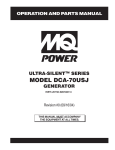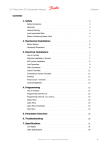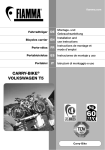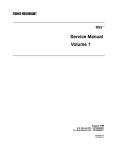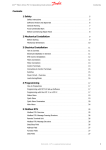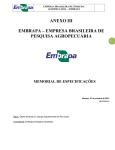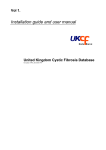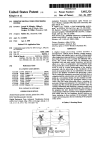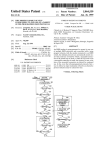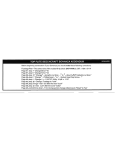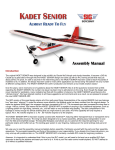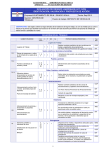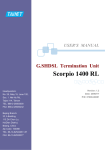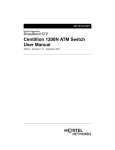Download Inverse multiplexing of digital data
Transcript
US006205142B1 (12) United States Patent (10) Patent N0.: Vallee (54) US 6,205,142 B1 (45) Date 0f Patent: INVERSE MULTIPLEXING OF DIGITAL FOREIGN PATENT DOCUMENTS DATA 0 584 398 . . 96/08120 (75) Inventor: Richard Vallee, Gatmeau (CA) 96/17489 (73) Assignee: Nortel Networks Limited (CA) ( * ) Notice: Mar. 20, 2001 3/1994 (EP). 3/1996 WO . 6/1996 EWO; ' OTHER PUBLICATIONS Subject to any disclaimer, the term of this Palmer’ “hfverse Multiplexing (if ATM Cells Over LOW patent is extended or adjusted under 35 Speed PNI S Such as T1 and U_S_C_ 154(k)) by 0 days' Sathe, ATM Inverse Multiplexing Mechanism , (1994). ’ (1994)‘ _ ” * cited by examiner (21) Appl' NO‘: 08/909’060 (22) Filed; Aug, 14, 1997 Primary Examiner—Alpus H. Hsu (74) Attorney, Agent, or Firm—Finnegan, Henderson, FaraboW, Garrett & Dunner, L.L.P. Related US. Application Data (57) (60) Provisional application No. 60/024,023, ?led on Aug. 16, (51) 1996' Int. Cl.7 ............................. .. H04J 3/02; H04L 12/56 (52) (58) US. Cl. ........................ .. 370/394; 370/395; 370/471; 370/536 Field of Search ................................... .. 370/389 394 370/395 400 408 465 470 471’ 474’ 476 477’ 506 536 542’ 543’ 544; ’ (56) ’ ’ ’ ’ ’ ABSTRACT In ATM networks, digital data in ATM cells are sent to a destination node Over more than One transmission link in round robin fashion This is Called inverse multiplexing At connection start-up, the source node informs the destination node of the Speci?c round robin fashion of the transmission links so that the ATM cells are reassembled in a proper sequential order. Inverse multiplexing control cells are used to communicate betWeen the source node and destination References Cited node for connectivity testing of transmission links. Cell U-S~ PATENT DOCUMENTS stuf?ng is also provided in one embodiment to accommodate non-synchronized links among transmission links. In a par 5 285 441 * 2/1994 Bansal et al. ...................... .. 370/228 ?cular embodimenh two Consecutive Control Cells indicate a 5’6O8’733 3/1997 Vance et aL stu?ing cell. A start-up procedure is described When not all 5:617:417 * 4/1997 Sathe et al. ........................ .. 370/394 5,875,192 * 2/1999 370/394 the transmission links are usable Cam et al. ......................... .. 370/474 5,970,067 * 10/1999 Sathe et al. ........................ .. 370/394 OCTET 1-5 74 Claims, 14 Drawing Sheets FIELD ATM CELL HEADER 6 IMA LABEL 7 CELL ID, LINK ID 8 IMA FRAME SEQUENCE NUMBER 9 ICP CELL OFFSET 10 LINK STUFF INDICATION 11 STATUS & CONTROL CHANGE INDICATION 12 Tx IMA ID 13 Rx IMA ID 14 GROUP STATUS & CONTROL 15 TX TEST CONTROL 16 Tx TEST PATTERN 17 Rx TEST PATTERN 18 LINK 0 INFORMATION 19 LINK 1 INFORMATION 20-49 LINK 2-31 INFORMATION 50-51 UNUSED 52-53 ORG-10 U.S. Patent Mar. 20, 2001 Sheet 1 0f 14 US 6,205,142 B1 EmOPwD mz a .QEN E.O5F2E‘ .GEv NEOFwD mzwa mwz a U.S. Patent Mar. 20, 2001 Sheet 2 0f 14 US 6,205,142 B1 BIT 8 7 6 5 4 3 2 1 VPI OR GFC VPI 1 VPI VCI 2 VCI VCI 3 PT CLP 4 HEC 5 |_ LLI 6 '6 O CELL PAYLOAD (48 OCTETS) 53 GFC: VPI: VCI: GENERAL FLOW CONTROL VIRTUAL PATH IDENTIFIER VIRTUAL CHANNEL IDENTIFIER PT: CLP: HEC: PAYLOAD TYPE CELL LOSS PRIORITY HEADER ERROR CHECK FIG. 3 PRIOR ART U.S. Patent Mar. 20,2001 Sheet 3 0f 14 US 6,205,142 B1 CE>L S 14 K AMA CD V12 LWM(#N UNK#1 LWU(#2 / /-1O AMA ATM CEL S FIG.4 U.S. Patent Mar. 20, 2001 2#8$.59E038 802358%90 j8:m$0Iou?2/-08k3z5 8w5j@o92?m0p$5z Sheet 4 0f 14 GEm US 6,205,142 B1 2@$G8M5I0EBO 8: .QEm U.S. Patent Mar. 20, 2001 Sheet 5 0f 14 OCTET 1 2 ALLOCATION AIM-RDI AIMFERR 3 4 AIMCSN(MSB) AIMCSN(LSB) 5 6 R R 7 R 8 9 10 11 12 13 14 15 16 17 18 19 20 21 22 23 R R R R R R R R R R R R R R R R 45 46 47 48 R R R CEC 1O MSB: MOST SIGNIFICANT BYTE LSB: LEAST SIGNIFICANT BYTE FIG. 7 US 6,205,142 B1 U.S. Patent OCTET 1-5 Mar. 20, 2001 Sheet 7 0f 14 US 6,205,142 B1 FIELD ATM CELL HEADER 6 IMA LABEL 7 CELL ID, LINK ID 8 IMA FRAME SEQUENCE NUMBER 9 ICP CELL OFFSET 1O LINK STUFF INDICATION 11 STATUS & CONTROL CHANGE INDICATION 12 TX IMA ID 13 RX IMA ID 14 GROUP STATUS & CONTROL 15 TX TEST CONTROL 16 TX TEST PATTERN 17 RX TEST PATTERN 18 LINK 0 INFORMATION 19 LINK 1 INFORMATION 20-49 LINK 2—31 INFORMATION 50-51 UNUSED 52-53 CRC-1O FIG. 10 U.S. Patent Mar. 20, 2001 I START Sheet 9 0f 14 US 6,205,142 B1 ) -START SENDING ICP CELLS OVER PROVISIONED LINKS -INDICATE LINKS IN GROUP -PROPOSE IMA ID AND FRAME LENGTH OVER ICP CELLS -CHECK STATUS OF PROVISIONED INCOMING/OUTGOING LINKS ~ " -STOP SENDING = -SEND GROUP GROUP ABORT ABORT SIGNAL SIGNAL AT LEAST P LINKS WITHOUT LINK DEFECTS? OVER ICP CELLS -START TIME-OUT TO SUSPEND START-UP A -REJECT LINKS WITH LINK DEFECTS -CONTINUE PROCEDURE WITH GOOD LINKS -CHECK IMA FRAME LENGTH AND ADJUST IF NECESSARY -CHECK IMA ID OVER GOOD LINKS -ENSURE PROPER LINK CONNECTIVITY AT LEAST P LINKS PROPERLY CONNECTED IN GROUP? -CHECK LDS FOR GOOD LINKS AT LEAST P RX LINKS IN V LDS? FIG. 13a U.S. Patent Mar. 20, 2001 Sheet 10 0f 14 I -SEND ICP CELLS WITH LDS BIT SET FOR RX LINKS IN LDS -LOOK FOR INCOMING ICP CELLS WITH LDS SET FOR ALL TX LINKS AT LEAST P TX LINKS IN LDS? -SEND “READY" SIGNAL ON ALL ACCEPTED LINKS AT LEAST P RX LINKS READY? ACTIVATE ALL READY LINKS AND START SENDING ATM CELLS OVER THEM FIG. 13b FIG. 13a FIG. 13b US 6,205,142 B1 U.S. Patent Mar. 20, 2001 Sheet 11 0f 14 LID=O US 6,205,142 B1 _ LID-=0 IMA A ‘ IMA B IMA C IMA D FIG. 15 U.S. Patent Mar. 20, 2001 Sheet 12 0f 14 xmQmZbcm. <QxmZvwp mMOMm0.1Z5I_0>OP2 mwIxPzOZ]< US 6,205,142 B1 U.S. Patent Mar. 20, 2001 Sheet 13 0f 14 US 6,205,142 B1 V V FIG. 17 V L|D=O IMAA ~ IMAB ID=1 ID=2 30 IMAC IMAD |D=1 L|D=0 ‘ L|D=O FIG. 18 ; |D=2 U.S. Patent Mar. 20, 2001 Sheet 14 0f 14 US 6,205,142 B1 TIME A (1) ICP SICP (2) ICP SICP (3) ICP (4) ICP (5) ICP (6) ICP (7) ICP SICP E ICP SICP SICP SICP ICP E E X FIG. 19 US 6,205,142 B1 1 2 INVERSE MULTIPLEXING OF DIGITAL DATA control. The framing bit is used to determine relative link delays While the link control bit is used for communication, control and administration betWeen tWo TC points at tWo ends of the inverse multiplexer. This application claims bene?t to US. provisional In order to establish the sequence of cells over the links in a round robin manner, one end is de?ned as being “master” and the other as “slave”. The “master” decides and 60/024,023 ?led Aug. 26, 1996. FIELD OF THE INVENTION informs the slave about the multiple link con?guration using the control channel implemented through the link control The invention relates to a neW mechanism for sending ATM cells transparently over multiple sloWer transmission links. In particular, the invention is directed to a method of inverse multiplexing of a series of ATM cells transparently 10 over N transmission links (N being a positive integer) of sloWer speed. BACKGROUND OF THE INVENTION 15 It has been recogniZed that the T1/E1 rate (1544/2048 Mbit/s) is a cost effective Way of user access to an ATM netWork as Well as connection betWeen ATM netWork sWitches. HoWever, as ATM technology for Wide area net Works is deployed more and more, demands for transmission links of a rate higher than Tl/El are increasing. Links of This protocol is only applicable, hoWever, for UNI appli cation points because GFC bits that are robbed to implement the TC layer are only present in a cell de?ned for UNI. For NNI cells, the corresponding bits are no longer available since they are captured under the VPI ?eld. Service provid ers are interested in ATM inverse multiplexers for carrying ATM traf?c at rates higher than Tl/El and loWer than T3/E3, but this protocol Will not satisfy their need. It should also be noted that the protocol calls for a need to identify a “master” and a “slave” TC point and that requires an additional setting to be performed by the netWork operator. Bit Pipe Inverse Multiplexing This protocol Was presented in “Physical Layer Sub Working Group ATM Forum/94-0956, Inverse Multiplexing higher rates, such as T3/E3 (44.736/34.368 Mbit/s), have been designed to meet these needs. HoWever, the cost of T3/E3 links is still prohibitive in many cases and the ratio of cost versus realistic utiliZation of the entire rate is not alWays attractive and fully justi?ed for neW ATM end users and bits. of ATM cells over loW speed UNIs such as T1 and E1”, 25 September 1994, by Digital Link Corporation. It proposes a “bit pipe” inverse multiplexing technique requiring the de?nition of a “bonding” (bandWidth on demand) like service providers. ATM inverse multiplexers (AIMs) have been proposed to satisfy the need by using multiple T1/E1 plexing. links Which are grouped collectively to provide the service It is not clear in the proposal hoW both ends of the links exchange information concerning the order of cells to be speci?cation for N (positive number) T1/E1 inverse multi at a higher rate. transferred from one end to another over multiple links. The FIG. 1 and FIG. 2 shoW tWo sample con?gurations in proposal mentions the existence and deployment of physical Which AIMs are used. FIG. 1 depicts a user access to a netWork through user netWork interfaces (UNIs) and FIG. 2 a link connection betWeen ATM sWitches through broadband inter-carrier interfaces (BICIs) or private netWork to net layer protocols that perform inverse multiplexing. The inverse multiplexer Which can be used in this proposal is 35 Work interfaces (PNNIs). 1993”. Referring to the ?gures, the basic function of AIMs is to Work in pairs to take an ATM cell stream coming from the The inverse multiplexing protocol de?ned in the above user’s manual relies on the de?nition of an extra bit taken ATM layer, send it over the multiple links by spreading cells from Tl/El payload bits to con?gure the multiple links and adjust differential link delays. This protocol introduces the need for extra processing of data betWeen devices dealing over the available links and ensure that the initial cell stream can be retrieved at the far end. Thus the AIMs preferably make the ATM traf?c transparent to the ATM layer over multiple links Which connect them. As far as the ATM layer is concerned, it should only see a pipe Whose rate is noW the sum of the multiple link rates. It is assumed that each link is run in clear-mode Without the presence of intermediate ATM nodes processing ATM cells. This means that there should be no cell discard by any intermediate transmission With Tl/El frames and ATM cell delineation. It also causes 45 DSl/El Physical Layer speci?cations. Changes like this providers Who are already using and deploying ATM equip ment. US. Pat. No. 5,608,733, Mar. 4, 1997, Vallee et al, describes good Ways of obviating the above noted problems. Currently no ATM inverse multiplexing protocols have been proposed Which can properly interWork existing ATM The patent uses ATM sequence number cells indicating a speci?c round robin order of a plurality of transmission links over Which ATM data cells are transmitted. The ATM 55 sequence number cells also indicate Whether or not a des tination is ready to receive ATM data cells in that speci?c round robin order. NeW Transmission Convergence Protocol Using GFC Bits This protocol Was presented in “Physical Layer Sub Working Group ATM Forum/94-0775, ATM Inverse Multi The present invention extends further variety of function alities Which are useful in inverse multiplexing. plexing Mechanism”, September 1994, by StrataCom Inc. The protocol robs tWo of the Generic FloW Control (GFC) bits contained in each cell transmitted over the multiple Tl/El links to implement a neW transmission convergence (TC) layer. FIG. 3 shoWs the ATM cell structure Which is de?ned in the ITU Recommendation. The TC layer is de?ned by one GFC bit for framing and the other one for link the ATM cells to no longer be byte aligned With the DSl/El frame. This is a requirement by the ATM Forum UNI Would not be Welcome by end users, vendors and service equipment. inverse multiplexers or other ATM products Which are already available on the market, and yet are ?exible enough to ?t into the current standard ATM speci?cations. TWo proposals for an ATM inverse multiplexing protocol have so far been made and are described in detail beloW. presumably the one de?ned by Digital Link Corporation in their “DL3800 DSl Inverse Multiplexer Users Manual, 65 OBJECTS OF THE INVENTION It is therefore an object of the invention to provide a method of sending ATM traf?c over a connection consisting of a plurality of transmission links. It is another object of the invention to provide a method of sending a series of ATM cells spread over a plurality of transmission links in a speci?c round robin order. US 6,205,142 B1 4 3 FIG. 5 shoWs preassigned cell header values for use by the It is yet another object of the invention to provide a method of sending ATM cells containing sequence numbers physical layer; therein over a plurality of transmission links in a speci?c round robin order. It is a further object of the invention to provide a method of sending a series of ATM cells betWeen ATM inverse multiplexers over a connection consisting of a plurality of FIG. 6 shoWs a header pattern of an AIM OAM cell, according to one embodiment of the invention; FIG. 7 indicates allocation of OAM functions in the information ?eld according to one embodiment of the inven tion; transmission links, transparent to the ATM layer. It is yet another object of the invention to provide a method of sending ATM traffic over a connection Which consists of a plurality of transmission links and has been 10 recon?gured after the connection start-up. It is still another object of the invention to provide an ATM inverse multiplexing method Which is applicable to UNIs, BICIs and PNNs. It is a further object of the invention to provide a method and demultiplexing of AIM OAM cells during transmission 15 of preserving link integrity by periodically sending sequence number cells. It is a further object of the invention to provide a method of handling link failure and link recon?guration. It is still a further object of the invention to provide a method of stuffing cells to accommodate non-synchroniZed links. 25 FIG. 16 shoWs the timing diagram of the test procedure of the invention. FIG. 17 illustrates looping of a test pattern at node B. FIG. 18 depicts diagrammatically a scenario Where the 35 preceding the stuff event and the stuff ICP cells are cor rupted. nection consisting of a plurality of transmission links, said data containing a series of ATM data cells. In particular, the method comprises steps of identifying N number of trans DETAILED DESCRIPTION OF PREFERRED EMBODIMENTS mission links over Which the series of ATM data cells are to 45 method further includes steps of receiving a series of inverse multiplexing control cells Whose receive ready ?eld is set to formed by P number out of N transmission links, P being a It must adjust up to 32 milliseconds of differential link delays betWeen individual links in a case Where T1/E1 positive integer smaller than N and ?nally sending each ATM data cell in said series of ATM data cells in said second links are used. speci?c round robin order. It must recon?gure multiple links in the event that a link has to be added, deleted or is considered inadequate to BRIEF DESCRIPTION OF THE DRAWINGS 55 provide service. It must be de?ned for not only UNIs but also for PNNIs and BICIs. It must be transparent to the devices handling the con vergence of ATM cells into the PDH signal. It must be transparent to the devices dealing With ATM for further objects and advantages thereof, reference may noW be made to the folloWing description, taken in conjunc tion With the accompanying draWings, in Which: FIG. 1 shoWs a sample con?guration involving AIM UNIs; layer cells. FIG. 2 shoWs a sample con?guration involving AIM The present invention achieves all of the above require ments and solves the problems discussed earlier. The inven BICIs or PNNIs; FIG. 3 depicts the ATM cell structure de?ned in the ITU FIG. 4 is a schematic illustration of multiplexing and demultiplexing of ATM cells over AIMs and links; There are requirements that have to be considered When de?ning a neW ATM inverse multiplexing protocol. These requirements are: It must multiplex and demultiplex an ATM cell stream distributed in a round robin manner over multiple links such as T1/E1 links. indicate a second speci?c round robin order in a group Recommendation; test pattern procedure can be used to detect a link that is not connected to the expected IMA. FIG. 19 shoWs cases (1, . . . , 7) When the ICP cell According to a further aspect, the invention is directed to a method of inverse multiplexing digital data over a con For a more complete understanding of the invention and start-up procedure according to one embodiment. are added to groups With active Link ID=0 links. multiplexing control cells in a frame, indicating cell stuf?ng. be transmitted, N being a positive integer and sending a series of inverse multiplexing control cells indicating a ?rst speci?c round robin order of the transmission links. The of ATM data cells according to one embodiment of the invention. FIG. 10 is an ICP cell format used for implementing embodiments of the invention. FIG. 11 shoWs a circumstance Where node Amay be using a group of three links to send data to node B and another group of tWo links to send data to node C. FIG. 12 shoWs a typical sequence of cells on a three link group. FIGS. 13a and 13b shoW an algorithmic ?oW chart for the FIG. 14 indicates hoW FIGS. 13a and 13b should be connected. FIG. 15 shoWs a con?guration When links With Link ID=1 SUMMARY OF THE INVENTION Brie?y stated, the invention reside in the inverse multi plexing digital data over a connection consisting of a plu rality of transmission links, said data containing a series of ATM data cells. According to one aspect, the invention is directed to a method of cell stuf?ng to prevent underrun in a plesiochronous AIM netWork. In accordance With a yet another aspect, the method further includes a step of sending tWo consecutive inverse FIG. 8 is a schematic illustration of multiplexing and demultiplexing of AIM OAM cells according to one embodiment of the invention; and FIG. 9 is a schematic illustration of periodic multiplexing tion relates to a neW ATM inverse multiplexing scheme that 65 makes use of a physical layer operation administration and maintenance (OAM) cell Which has been properly de?ned. This OAM cell is de?ned to contain valuable information to US 6,205,142 B1 6 5 allow proper operation of the ATM inverse multiplexing mechanism and also to provide opportunity for handling a ATM inverse multiplexing remote defect indicator (AIMRD1)—one octet is allocated and the proposed coding is all “1”. ATM inverse multiplexing far-end receiver ready (AIMFERR)—one octet is allocated and the proposed coding is all “1”. ATM inverse multiplexing cell sequence number link failure situation. The neWly de?ned OAM cell is called an AIM OAM cell or AIM Sequence Number (SN) cell and is mainly designed to carry a cell sequence number and a feedback link status ?eld. The sequence number in the SN cell is made available for the receiver end for recovering the initial cell stream from the incoming links. The feedback link status is made available for the receiver to inform the transmitter, by sending its oWn SN cells, that it is receiving cells and it is also an integral part of the same round robin mechanism, 10 (AIMCSN)—it is de?ned to contain the sequence num ber of the cells sent over the multiple links handled by the ATM inverse multiplexers. It is designed so as to have a suf?ciently large cycle to alloW the ATM inverse multiplexer to absorb link delays of up to 32 millisec that is to say, the feedback link status value SN cells in either onds. There are 16 bits allocated to the AIMCSN ?eld. direction must agree With each other, although the sequence The counting is then done modulo 65536. numbers at both ends may be different. When the receiver sends its oWn SN cells in response to the transmitter that it 15 cell payload. It is proposed to CRC-10 as proposed in ITU Recommendation 1.432. is receiving cells, it is in fact acknoWledging that the receiver is ready to receive subsequent ATM data cells. Reserve ?eld (R)—contains the octet pattern of FIG. 4 shoWs hoW the ATM cells are multiplexed and then demultiplexed over AIMs in one direction. At the transmit ting node, an AIM 10 takes a series of ATM cells from an “01101010”, Which is the same as that of the idle cell as proposed in ITU Recommendation 1.361. Referring to FIG. 8, the ATM inverse multiplexing pro ATM layer device. It spreads ATM cells and transmits each cell over each of N transmission links, N being a positive integer. The order of transmission is in round robin fashion. This process is called an inverse multiplexing. At the receiv tocol according to one embodiment is described in detail beloW. The ?gure only shoWs one direction for clarity. It is shoWn that transmission links are all Tl/El links but, of 25 ing node, cells from N links are inverse demultiplexed proper sequence of cells. Both nodes must be aWare of the round robin order Which is to be employed. Upon initialiZation, therefore, both AIMs send a series of SN cells in round robin fashion over the links, e.g. Tl/El links. This alloWs the receiver AIM at both nodes to establish the transmission to a receiving node 26. An AIM at the receiving node reassembles ATM data cells received from the links in proper order and sends them to the ATM layer. Link Start-up Upon connection start-up, AIMs at both nodes start insert 35 to be transmitted on the virtual link (composed of N physical links). HoWever, the sequence number is only carried over the SN cells. This sequence number assignment alloWs the receiving AIM to retrieve the original cell sequence. The receiving node queues the received AIM SN cells until it to the same link round robin. This information can then be used locally to determine if at the corresponding local node a link should be added, removed or maintained in the round robin. When a change of link con?guration occurs by a link being added, removed or declared as being doWn, each node sends a series of SN cells to alloW the far-end node to 45 OAM cell that is de?ned to be exclusively processed by the determines the sequence in Which to read the ATM data cells from the incoming links as Well as the differential delay among individual links. Then, it starts sending AIM SN cells of its oWn, With the AIMFERR ?eld set to “one” for each link Which is noW considered “ready” to receive ATM traf?c. From that moment, the receiving node knoWs the sequence of cells coming from the links. A link is being considered available if cells are currently delineated and AIM-RDI is ATM inverse multiplexers. The neW cell structure has to be consistent With the cell structure de?ned in ITU Recom mendation 1.361. FIG. 3 shoWs that structure of UN1/NN1 ATM cells that is de?ned in 1.361. ITU Recommendations 1.361 and 1.432 state that ATM cells consisting of a header not received on the incoming link. When the transmitting node starts sending the AIM SN cells, it starts a time-out of 100 milliseconds Within Which Whose VPI and VCI ?elds are set to Zero are reserved for use by the physical layer. So far three preassigned values of the ing AIM OAM cells (AIM SN cells) carrying cell sequence number over the available links in round robin fashion. The sequencing of cells is based on the order in Which cells have used by each Tl/El link to indicate that both AIMs belong reestablish the sequence of cells to read from the incoming links. The protocol of the invention calls for a physical layer course, links can have a different speed from Tl/El, as long as all the links have the same speed. A transmitting node 20 collects digital data consisting of a series of ATM data cells from the ATM layer. An ATM inverse multiplexer (AIM) at the transmitting node spreads over multiple links 24 for (assembled) and sent to an ATM layer device by an AIM 14. The same order must be employed at this node to recover a sequence in Which to read cells from the incoming links as Well as to adjust relative link delay. As mentioned above, the SN cell also carries an extra ?eld Cell error control (CEC)—is used to detect errors in the 55 the receiving node determines the sequence of AIM SN cells Which it is receiving from the links. The time-out expires cell header are reserved for use by the physical layer. They unless the transmitting node receives the “ready” signal are shoWn in FIG. 5. from all the links Which Were considered available at the The physical layer OAM cell according to one embodi ment of the invention is then de?ned by using a non assigned value by setting the PT ?eld to “111” or some such code. This is shoWn in FIG. 6. The A1M OAM cell payload is then available for initialiZation. If there is no “ready” link When the time-out expires, the local node reevaluates the availability of the links (using cell delineation), starts sending AIM SN cells over the available links and re-starts the time-out This procedure is repeated exchanging information betWeen AIMs. The cell payload until at least one available link is declared ready. consists of a series of ?elds Whose locations are shoWn in When the time-out has been cancelled due to the reception FIG. 7. 65 of the “ready” signal from all the available links, or When The folloWing ?elds are identi?ed for the AIM protocol according to one embodiment of the invention: there is at least one link ready When the time-out expires, the local end starts sending ATM layer cells over the “ready” US 6,205,142 B1 8 7 link or links using the same round robin order used at the time of initialization. Cell Sequence Number Range Each ATM layer cell gets a sequence number assigned to it, but only the AIM SN cells carry that number across the differential delay betWeen individual links of up to 32 milliseconds in one embodiment, and because the system needs to deal With a maximum of 8 Tl/El links, it is necessary to have a sequence number Whose modulo is large Because an ATM inverse multiplexer must absorb a links. After both nodes have started sending ATM layer cells, they periodically send a series of “n” AIM SN cells over links to alloW the receiving node to readjust the differential enough to accommodate such delay. As a practical example, the folloWing parameters for E1 delays among the links. The value of “n” is equal to the number of “ready” links used to carry AIM layer cells. This means that the receiving node alWays scans for AIM SN cells in order to determine if it is alWays reading cells from the multiple links in the correct order. HoW often a burst of “n” AIM SN cells is sent depends upon the link utiliZation but the maximum period has been set to 50 milliseconds in are considered: full rates: 2.048 Mbit/s payload rates: 30/32*2.048 Mbit/s=1.92 Mbps one embodiment. An example of cells sent over a virtual link 15 composed of a plurality of transmission links is shoWn in FIG. 9. ATM cell: 53 bytes ATM cell period time: 221 microseconds ATM cells/32 milliseconds=144 cells. For a delay of up to 32 milliseconds on each link, there is a need to queue cells for at least the same length of time on Link Recon?guration tion also deals With link recon?guration. There are three each link. Therefore, in this example, this means that a delay of up to a period of 144 cells betWeen tWo links is possible. An ATM inverse multiplexer can handle a maximum of 8 possible cases in Which recon?guration can occur: a neW link has to be added to the round robin; a link has to be intentionally removed from the round Tl/El links. Therefore up to 1008 cells (144*7 cells) must be queued at one time by one ATM inverse multiplexer. This requires a sequence number modulo large enough to cover As mentioned above, the protocol according to the inven robin; and a link has been declared inadequate to provide service this scenario. A simple case in one embodiment is to use a 25 In the ?rst tWo cases, a node starts link recon?guration by performing the same initialiZation process for a connection start-up, that is to say, it chooses a round robin order among the links and starts sending AIM SN cells using the chosen round robin order. The receiving node, seeing the occurrence of AIM SN cells, Will stop transmitting traf?c and starts sending AIM SN cells of its oWn While adjusting itself to receive traf?c from the incoming links. The rest of the protocol is as described earlier for start-up. TWo possible cases for reporting failure conditions are: 16-bit count that has modulo 65536. The ATM inverse multiplexing protocol according to the invention realiZes the folloWing characteristics: it is applicable to UNIs, BICIs and PNNIs (any applicable points in an ATM netWork); it does not affect the ATM cell header of currently de?ned (eg link doWn by failure etc.). cells; it does not require a change to current ATM physical layer devices dealing With the convergence of ATM cells into 35 Tl/El; it operates transparently to the ATM layer; it does not require a change to current devices dealing 1) A medium problem reported through Loss of Delinea With the processing of the ATM layer cell; tion (LCD) failure condition. In this case, the corresponding link should not be used for service. When detecting LCD, it is self-con?guring among available links upon start-up and self-recon?guring among the multiple links in the SN cells With AIMRDI set to “1” should be sent over the corresponding outgoing link. SN cells containing AIM-RDI case When a neW link has to be added, deleted or do not carry a valid sequence number. At the far end, the considered inadequate to provide service; and detection of AIM-RDI signals Will indicate that the link is not to be used. Therefore, if LCD or AIM-RDI is detected, the link is no longer considered available and Won’t be alloWed to be part of the round robin on both sides. When this has happens, SN cells are re-sent over the remaining links to reestablish the connection betWeen the tWo ends. 2) Cells are lost Without an LCD or AIM-RDI being reported. For instance, this Would occur When a feW cells are it includes a sequence number Whose modulo is large enough to meet the requirement of a large differential 45 delay among the links. An embodiment of the present invention, involves special one or more of the previous cells are missing). In this case, 55 Inverse mux Controller Processor (ICP) cells, Which are more detailed versions of the SN cells. The ICP cell format is shoWn in FIG. 10. In this embodiment, ATM cells are transmitted over an N number of links, N being a positive integer. Cell ID is set for ICP cell and Link ID identi?es links being used. As seen in FIG. 11, a node A may be using a group of three links to send data to node B and another group of tWo links to send data to node C. Nodes A and B form one IMA group and nodes Aand C form another. IMA groups are the problem might be partially corrected by re-adjusting the receiver buffering system (assuming the difference betWeen identi?ed by IMA ID (Tx and Rx IMA ID). ATM cells on each link are grouped in a certain number (e.g., M) of cells the SN cell number and the expected number is small). The to form IMA frames Which belong to substantially same time scale. An IMA frame sequence number ?eld counts cells in discarded by the physical layer device due to bit errors in cell headers. This Would cause the cell sequencing to be affected. One symptom Would be the detection of SN cells Whose number is no longer the same as that expected (since other symptom Would be the absence of a SN cell on one link When getting a burst of SN cells on all the other links. In that case, the local end Would have to force the links to be re-con?gured. If the symptoms described above reoccur over a given period, the bad link may have to be removed from the round robin. A link recon?guration also occurs When it takes too much time for one link to receive cells from the far-end (receiving) node, that is to say, no cells Within, e.g., 32 milliseconds. each group. FIG. 12 shoWs a typical sequence of cells on a three link group. One ICP cell is sent at a set location in each 65 group for each link. M can be any number, for example 32, 64, 128 and 256. In the ?gure, on link 0, the ICP cells have their cell offset set to Zero (i.e., they are the ?rst cell in the IMA frame). On link 1, the ICP cells have the ICP cell offset set to 3 and on link 2, the ICP cells have their ICP cell offset set to 1. In practice, these ICP cells should be distributed US 6,205,142 B1 9 10 even more over the IMA frame but are shown closer for ease trates looping of a test pattern at node B. The transmit node receives and veri?es Rx Test Pattern returned over the other links. It noW knoWs that all the links Which belong to the of illustration. The ICP cell also includes ?elds concerning With stuffing action and test control action, both of Which Will be described in detail beloW. A status and control change indication ?eld is used to same IMA group. FIG. 18 depicts diagrammatically a scenario Where the test pattern procedure can be used to detect a link that is not connected to the expected IMA. Links identi?ed as Link indicate an update of the link status ?eld value. The value is incremented to indicate a change on at least one of the link status ?elds. The ?eld is also used as a tag to differentiate ID=1 are being added to existing groups using links With Link ID=0. Link 30 carries the IMA B Test Pattern to looped back by IMAA and links 32 and 34 carry the IMA D Test link status changes over time. The ?eld Will alWays remain set to the same value as long as there Will be no change on any link status ?elds. If one or more link status ?elds need Pattern to be looped back to IMA B. In this case, the Wrong test pattern Will be received by IMA B. If IMA B Was not to be modi?ed, ICP cells With neW link status values commanding a Test Pattern loopback, IMA B Would simply incremented Will be sent over all the links. not receive the right test pattern. A group status and control ?eld is used to indicate status The Test Pattern procedure also alloWs to deal With some of the group of links at a connection start-up, link addition 15 pathological cases. One of them is When tWo IMA connected and abort procedures. In particular, the start-up procedure to the same far end IMA node are trying to start-up at the Would become complicated if one of the links does not meet same time. The far end (receive end) node Will have to determine Which set of links (corresponding to one end) it Wants to be connected to. This Will require the received end to select the link(s) to be part of the group, as mentioned above, the receive end shall only respond to one Test Pattern all the criteria to be part of the group (eg link cleared of defects, corresponding incoming/outgoing links in loss of delay synchronization). This requires intervention of the operator to remove the bad link(s) from the link group. FIGS. 13a and 13b as combined in the Way shoWn in FIG. 14 shoW an algorithmic ?oW chart for the start-up procedure according to one embodiment. Instead of requiring all N number of links in the group being good before starting up, command at a time that has been validated over one or more 25 links that are or likely to be recogniZed as part of the group. In accordance With a further embodiment, a stuff cell is the procedure of the invention proceeds as long as there is at least P out of N “good” link available for service. A good inserted to control cell rate decoupling betWeen the links, in link is de?ned as a link that is not exhibiting link and each other Within the link groups. The transmitting node loss-of-frame defects, recogniZed as being part of the group, and having an acceptable link differential delay. The value of P could be any number less than N. The ?gure also shoWs may be locked to one clock source or may be plesiochro nous. When plesiochronous, one of the buffers at the trans cases Where the group start-up is aborted and later resumed. The ICP format also includes a ?eld for links connec tivity testing at the time of start-up, link addition or link re-activation. In particular, a protocol must alWays ensure proper connectivity of the links Which belong to a group. For example, FIG. 15 shoWs When links With Link ID=1 are added to groups With active Link ID=0 links. TWo neW links order to accommodate the use of links non-synchroniZed to mitting node may be depleted. To prevent underrun, the cell stuf?ng procedure is invoked. When there is one clock source, the buffer Will never deplete. The transmitting node send ICP cells Which indicate a cell is stuffed at a certain 35 location Within the IMA frame. Any cell can be used for stuf?ng as long as the location is indicated so that the receiving node can remove it. In actual embodiment, the transmitting node repeats the ICP cell containing the stuff code indicating that “this cell is 1 out of 2 stuff cells”. The receiving node uses the stuff indications over the ICP cells to determine When to remove stuff cells from the incoming (Link ID=1 links) are inversely connected With respect to the expected con?guration. The dif?culty is then that both Link ID and IMA ID are the same for tWo independent IMAs. cell stream. The receiving node relies on at least one ICP cell This can cause an invalid con?guration Which Will not be With a correct CRC-10. Amore robust approach is to look for detected. This kind of problem can occur at a start-up, link a majority of valid codes. addition or even at a link re-activation. For example, it is FIG. 19 shoWs cases (1, . . . , 7) When the ICP cell possible to reactivate a link Which has exhibited a link 45 preceding the stuff event and the stuff ICP cells are cor failure since it has been accidentally inverted With another rupted. Corrupted cells are indicated by crosses in the ?gure. link With or Without the same Link ID and IMA ID. IMA ID SICP indicate stuf?ng control cells. The receiving node maintains synchroniZation for cases 1, 2, and 3. The receiv is also used to detect loopback situations. This problem occurs When both end nodes of the IMA virtual link Wants to use the same IMA ID. The invention addresses this ing node optionally maintain synchroniZation for cases 4, 5, and 6. The receiving node optionally maintain synchroniZa problem also. tion for case 7 if b>2 and When passing stuff indication over more than one of the previous ICP cells. “b” is the number According to a further embodiment, the above problems are solved by sending a test pattern contained in ICP cells over a link to be validated. The test pattern Will be looped back over all the other links in the group at the far end node. of invalid/corrupted ICP cells before declaring the link OIF 55 (out-of-IMA frame). This ensures that the tested link is connected to the same end node as the other links. What is claimed is: 1. A method of inverse multiplexing digital data over a When one IMA node Wants to determine if one or more Tx Test control ?eld for link test in an ICP cell. It identi?es connection consisting of a plurality of transmission links, said data containing a series of ATM data cells, comprising steps of: sending a series of inverse multiplexing control cells indicating a speci?c round robin order in Which the Link ID, Tx IMA ID, Rx IMA ID and inserts Test Pattern in series of ATM data cells are to be transmitted over the links are connected to the same far end IMA node, it selects one link for testing. FIG. 16 shoWs the timing diagram of the test procedure of the invention. The transmit node sets the the cell. It continues to send same ICPs. The receive end node receives the ICPs and copies Tx Test Pattern onto Rx Test Pattern. It keeps sending same test pattern copied on Rx Test Pattern ?eld over its all outgoing links. FIG. 17 illus connection; receiving from the plurality of transmission links a series of inverse multiplexing control cells Whose receive ready ?eld is set;


























